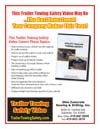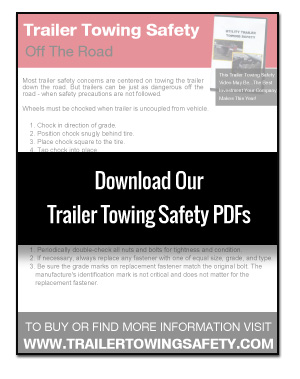|
Most trailer accidents are not caused by careless or reckless driving. Improper loading of a trailer causes the trailer and tow vehicle to become nearly impossible for even the most skilled driver to handle. Trailers must be carefully weighed to make sure that loads are properly distributed, front to rear as well as left to right. There are two additional considerations with trailer weights:
- Tow Vehicle-do not exceed the GVWR of the tow vehicle. This includes the curb weight of the vehicle, payload, and hitch weight. Hitch weight is the percentage of the trailer weight that is placed on the trailer coupler of the tow vehicle. (Refer to the next section on Trailer Vehicle Hitch Weight.) Tow vehicles also have GAWR limits. Payload and hitch weight must be divided evenly between the axles to conform with the maximum weight limits and to avoid oversteering problems.
- Trailer Vehicle Hitch Weight-approximately 10-15 percent of a trailer's gross weight is designed to be loaded in front of the front axle and onto the hitching mechanism. This ensures needed stability for road handling. If your trailer is not stable, you may have a problem with not enough weight on the hitch. Here are some methods to figure out hitch weight:
- Park your loaded trailer on a scale so the hitch coupler extends beyond the end of the scale, but the tongue jack post (the post on the front of the trailer which rests on the ground when unhitched) is on the scale.
- Block the trailer vehicle wheels, unhitch the tow vehicle, and obtain a weight rating. This is the curb weight of the trailer vehicle alone.
- Place a jack stand (or 4" x 4" blocks) under the coupler (beyond the scale) so that the tongue jack post is supported off the scale and the trailer is fairly level. Note this weight rating.
- Subtract the reading in #2 from the reading in #3 for the hitch weight.
|
*Remember to load your trailer with more weight in front of the trailer axle than behind it. A trailer with too much weight on the back end can put it and the tow vehicle into a violent and uncontrollable "wag" that can literally flip the tow vehicle.
Overloading a trailer can cause serious injury or equipment damage. Each trailer comes with guidelines to assist in prevention of overloaded trailer accidents. The Gross Vehicle Weight Rating (GVWR) is the maximum total trailer weight with the engine driven welding generator and all equipment, such as tools, cables, and shielding gas cylinder, installed. The Gross Axle Weight Rating (GAWR) is the maximum load-bearing capacity of the axle(s).
Incorrect tongue weight can cause fishtailing and loss of control of towing vehicle resulting in serious injury and equipment damage. Tongue weight is the amount of trailer weight that rests on the towing vehicle hitch - that is, the downward pressure on the coupler. Remove or adjust trailer load to get correct tongue weight. Do not let tongue weight exceed coupler and hitch rating.
|


